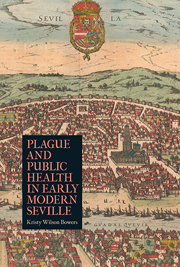Book contents
- Frontmatter
- Dedication
- Contents
- Acknowledgments
- Introduction
- 1 Early Modern Seville: Balancing Growth and Governance
- 2 Perceptions of Plague: Balancing Disease Concepts
- 3 Negotiating Public Health: Balancing the Individual and the Community
- 4 The Wider Politics of Public Health: Balancing Urban and Rural
- 5 City and Crown: Balancing Authorities
- Conclusion
- Notes
- Bibliography
- Index
2 - Perceptions of Plague: Balancing Disease Concepts
Published online by Cambridge University Press: 05 October 2013
- Frontmatter
- Dedication
- Contents
- Acknowledgments
- Introduction
- 1 Early Modern Seville: Balancing Growth and Governance
- 2 Perceptions of Plague: Balancing Disease Concepts
- 3 Negotiating Public Health: Balancing the Individual and the Community
- 4 The Wider Politics of Public Health: Balancing Urban and Rural
- 5 City and Crown: Balancing Authorities
- Conclusion
- Notes
- Bibliography
- Index
Summary
Early Modern Plague
Coping with plague in the early modern era required a multifaceted balancing act by both officials and residents. Although not all the balances discussed in this and subsequent chapters were performed consciously or with foresight, in the end they nonetheless achieved their unacknowledged goal: to protect individual health while also protecting the health and functioning of the community. To do so, officials found themselves struggling to balance a variety of needs.
The next chapter will explore the actions of the officials as they sought to keep the city running as smoothly as possible. To better understand those actions, however, it is necessary too understand the context in which they were undertaken. Therefore, this chapter examines the variety of beliefs about plague—what caused it, how it spread, who was at risk to contract or spread the disease, and how best to treat the sick—that informed the decisions of city officials. Much like today, public health decisions were rarely simple and nearly always involved balancing health interests against other social and economic needs. Medical officials rarely diagnosed an epidemic as exclusively plague. Instead, they often saw multiple sicknesses, which they termed plague (mal de peste), typhus (tabardete), or simply a general contagion (mal contagioso). The signs that physicians looked for to diagnose pestilence, including the bubo (landre) and carbuncle (apostema), could be identified as “pestilence” or “contagion,” but the terms themselves were not unique to plague.
- Type
- Chapter
- Information
- Plague and Public Health in Early Modern Seville , pp. 30 - 51Publisher: Boydell & BrewerPrint publication year: 2013



